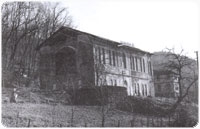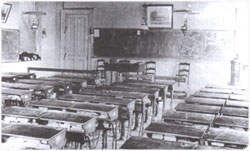The First Years

Üsküdar American Academy was originally founded in 1876. The site in Bağlarbaşı was originally the American College for Girls. ACG vacated the Bağlarbaşı site in 1914 and moved to Arnavutköy leaving the Bağlarbaşı campus empty from 1914-1921 except for the years 1914-15 when the buildings of our school were used as an orphanage by the Americans and the years 1915-1918 when the Turkish army used the school for barracks.
When Üsküdar American Academy for Girls was looking for a new location in Istanbul, it moved to the present site in Bağlarbaşı in the early 1920’s. With its new site and in the spirit of the new Turkish republic, the school became dedicated to quality education for girls.
One of the original Turkish principals of our school, Semiha Malatyalıoğlu, shared some of her memories of the earlier years of Üsküdar American Academy, which you can find further down on this page. She graduated from this school in 1928 and served as the Turkish vice principal for 37 years.
Her primary impressions about the school revealed the closeness of students and faculty at Üsküdar American Academy.
AMERICAN ACADEMY IN 1925
 In 1925, the education at the school was being done in the basement of Barton Hall and in Bowker Hall. The Round House was in the same place as it is today. There was a wooden black building in the place of Emir Konak.
In 1925, the education at the school was being done in the basement of Barton Hall and in Bowker Hall. The Round House was in the same place as it is today. There was a wooden black building in the place of Emir Konak.
There was originally a stable on the site where Kinney Cottage stands today. The school’s need for milk was met by the cows that lived in the stable. The stable was later demolished and the Practice House (Kinney Cottage) was built as a homemaking skills practicing center for the seniors.
The building was named Kinney Cottage in memory of Mary Kinney who was the principal of the school when it moved from Adapazarı.
The old organ in the auditorium was given by Robert College to be used in the frequent choral programs.
AMERICAN ACADEMY IN 1950
A "time capsule" at Çalıdere Cottage was discovered. The capsule contained some objects placed there by the builder of the house Dorothy Blatter, an art teacher and author that worked at the school from 1931 to 1961. She had the house built in the fall of 1950 and apparently placed her time capsule behind a small corner stone in the wall of the house on December 21, 1950. The property upon which the house was built remains a part of the UAA campus today. In 1996 construction of the newest faculty housing was completed on the same land that Dorothy acquired.
SEMİHA MALATYALIOĞLU'S MEMORIES OF AMERICAN ACADEMY
 Of course, the school in its first years was very different from the school today. Half of the student body, for example, could occupy the old Study Hall.
Of course, the school in its first years was very different from the school today. Half of the student body, for example, could occupy the old Study Hall.
The total number of students in the kindergarten, primary, and junior high school classes was only 242. There were 3 Muslim Turkish students among the Christian students in the lycee classes. As one of these students, Semiha Malatyalıoğlu talked about being a Turkish Muslim and not being able to share the celebration of her religious holidays with her classmates or of her friends not whole heartedly sharing her enthusiasm for the new Turkish nationalism that was filling the air. These were awkward days in the transition from the Ottoman Empire to the Turkish Republic. After the Lausanne treaty and the resulting new Education Law, like other foreign schools, the kindergarten and the primary sections of our school were closed and the school continued with the junior high school under the Turkish Ministry of Education.
Education after the 9th grade was divided into 3 sections as "Collegiate", "Commercial", and "Home Economics". The "Collegiate" section prepared girls for university education. The "Commercial" section prepared them for a trade and "Home Economics" section prepared girls to be a housewife.
Old commencements were adorned with written essays. Some essays were read in addition to music concerts and songs by the school choir. After 1926, the staff of the school started to change. American teachers were added to the faculty. Besides this, the biggest change was that the Turkish cultural lessons were added to the education curriculum. These lessons were now taught by Turkish teachers.
With the mobilization for education that was begun in the early years of the new Turkish Republic the foreign schools attracted the attention of Muslim Turkish students. The number of Turkish students increased dramatically. The extracurricular activities in the school increased. The traditional May Day was a celebration day that all students looked forward to with the May pole dance and other special activities. Students were also active participants in Turkish national celebrations.
As the years passed the school gradually changed adapting to the changes within Turkey.
MS. MARTIN AND MS. MORGAN
Jessie Martin is a very important part of UAA's history. The restoration of Barton Hall in 1946, and the construction of Huntington Hall and Martin Hall in 1955 were all accomplished during the time when UAA was directed by Ms. Martin. To honor Jesse Martin one of the new buildings was named Martin Hall.
Helen L Morgan was the director of UAA from 1956-1977. Like Ms. Martin, Ms. Morgan also worked hard to make UAA one of the best schools in Turkey. To add to the one lab that was present, the physics lab, Helen Morgan was responsible for the cistern being turned into a chemistry lab while Fred Shepard was responsible for the hamam being turned into a biology lab. The newest building at UAA with modern science laboratories and a computer center was named Morgan Hall in Helen L. Morgan's honor.
UAA 120 YEARS LATER
Üsküdar American Academy experienced a radical change in 1990 when it admitted boys for the first time into the Orta Prep class. With this change, "Üsküdar American Academy for Girls" became part of history and the school became known as “Üsküdar American Academy”. With the help of USAID grants, the Sabancı Foundation, supportive parents, and the Health and Education Foundation (SEV) physical changes have also continued with the building of a gymnasium, the restoration of Bowker and Barton Halls, and the construction of Morgan Hall, our science and computer building.
Üsküdar American Academy continues to pursue “excellence in education” in a time of rapid change within the Turkish culture.
Today the school, like the affiliated American schools in İstanbul, Izmir and Tarsus is under the governance of the Health and Education Foundation, which carries full responsibility and authority for operating the school. The school properties are also owned by SEV.
 With the passing of the 8-year basic education law, Üsküdar American Academy, like all foreign schools, gradually phased out the middle school, added a prep section for the lycee and now maintains only a lycee program. To fill in the void left by the closing of the Orta schools, SEV has opened an elementary school that goes through the eighth grade, offering quality English instruction to supplement the Turkish curriculum. It is hoped that the tradition begun so many years ago will continue for many years to come through SEV elementary schools and Üsküdar American Academy.
With the passing of the 8-year basic education law, Üsküdar American Academy, like all foreign schools, gradually phased out the middle school, added a prep section for the lycee and now maintains only a lycee program. To fill in the void left by the closing of the Orta schools, SEV has opened an elementary school that goes through the eighth grade, offering quality English instruction to supplement the Turkish curriculum. It is hoped that the tradition begun so many years ago will continue for many years to come through SEV elementary schools and Üsküdar American Academy.